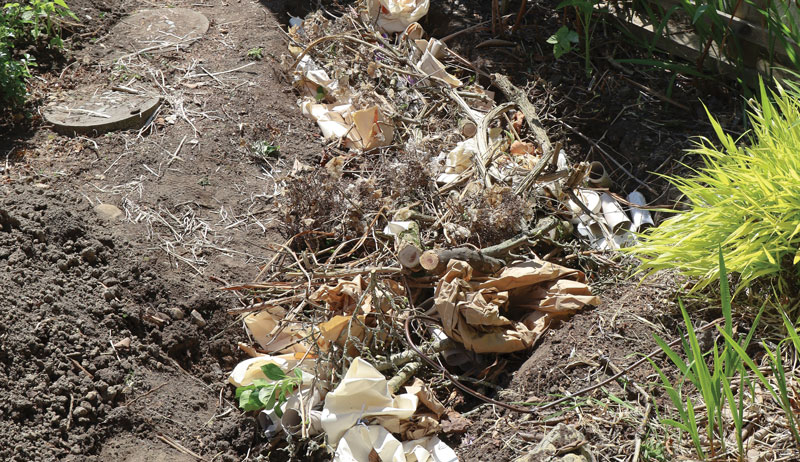
A hügelkultur is a mash-up of a slow/cool compost pile and a garden bed. It allows you to create a foundation using materials that take a long time to compost at the bottom of the bed, such as rotting logs, branches, sticks, woody vines, eggshells and fruit pits. This woody layer is covered with carbon-rich materials and compost. Green waste and manure can also be added, similar to the layers in sheet mulching. The mound is finished with a layer of compost that can planted. The materials in the center of the beds take a long time to break down, so this compost pile is useful as a self-feeding, long-term garden bed. It is beneficial to plant biodynamic or wild plants, which will continue to act as soil fixers, break down the organic matter, and add nutrients to the soil.

A hügelkultur is well-suited to a woodland or forest in order to efficiently use fallen tree branches and create rich beneficial garden beds and soil. This concept can also be created in home gardens as a feature for growing all sorts of annuals, perennials, food crops, and ornamentals. Hügelkultur gardens are very good at holding water and heat as they decompose, so plants will enjoy early crops and longer seasons.
Read more: You can use hügelkultur nursery beds for bare-root trees!
Decomposing Wood as Water Retention
While most compost and mulch systems require the organic material to be in small or chopped up pieces in order to accelerate decomposition, there is huge value in adding large pieces of rotting wood and branches to gardens to hold moisture and encourage beneficial fungi. In new garden beds, this helps to inexpensively fill the space without a need to bring in heaps of new soil while at the same time increasing water-holding ability.

The space around the wood is then filled with compost, organic matter and carbon materials to create a slow compost pile. Top the bed with a foot of compost, and plant directly into it. This type of bed will need much less watering throughout the season and works well for nutrient-hungry crops such as blueberries or potatoes.
More Information:
Make It!
- Map out the location that you would like to build a hügelkultur using flour or string. Dig the hole at least 18 to 24 inches deep.
- Add rotting logs, sticks and twigs to fill the basin and
create a mound. - Fill in the spaces between the logs and branches with other slow-to-decompose materials such as woody vines, eggshells and fruit pits.
- Add a layer of carbon material (such as paper, straw or leaves) over the top of the woody layer.
- The top layer can be 6 to 8 inches of compost, which you can plant right into. However, feel free to add more layers to the mound. A layer of green waste on top of the compost will speed decomposition. A layer of well-composted manure will feed the plants while the layers below decompose. If you add these additional layers, then top with a final 6 to 12 inches of compost on top for planting.
Planting Tips
- Mound slow-to-decompose materials such as rotting logs and branches, cover with a carbon layer, and then add a top layer of compost that can be planted.
- Add other slow-to-decompose materials such as fruit pits and eggshells to the mound. Add more layers on top of the compost such as manure and carbon sources, and then top with more compost and mulch around the plants.
- Plant hügelkultur with biodynamic or wild plants.
This article, which originally appeared in the March/April 2022 issue of Hobby Farms magazine, was excerpted and printed with permission from The Regenerative Garden: 80 Practical Projects for Creating a Self-sustaining Garden Ecosystem (Cool Springs Press, 2022) by Stephanie Rose, founder of GardenTherapy.ca and award-winning author and teacher of organic gardening and permaculture.




